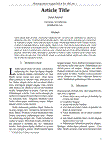| Sumario: | Each and every year hundreds of studies are published on the nutritional requirements of aquatic animals and the composition and nutritive value of different feed ingredients. However, knowledge integration efforts carried out in recent years at the UG/OMNR Fish Nutrition Research Laboratory have indicated that, in general, less than 50% of the published studies have appropriate experimental design, contain sufficient information or have results deemed sufficiently meaningful and credible results to be used in statistical meta-analyses. Small but meaningful improvements in the objectives, scope, and experimental design of research trials, as well as, in the quality and completeness of information reported in scientific papers could greatly improve the quality and relevance of research efforts in aquaculture nutrition.Research trials should be designed with the perspective of potential end users (e.g. feed manufacturers) in mind. Nutrient requirements trials should not ideally have fewer than six (6) graded levels of the nutrient studied and report sufficient information on the composition and digestibility of the experimental diets, and growth performance and body composition of the experimental animals. In the case of research on the nutritive value of feed ingredients, more emphasis should be on assessment of available nutrient “contributions” of ingredients to the diet (i.e. the bioavailability of nutrients in ingredients) rather than “absence of effect” of test ingredients when included in luxurious (e.g. high fish meal) diets. Finally, nutritional models and data integration and analysis systems should be developed and widely used to more effectively compile, analyze, interpret and valorize information generated by aquaculture nutrition research efforts carried out around the world.
|
|---|
